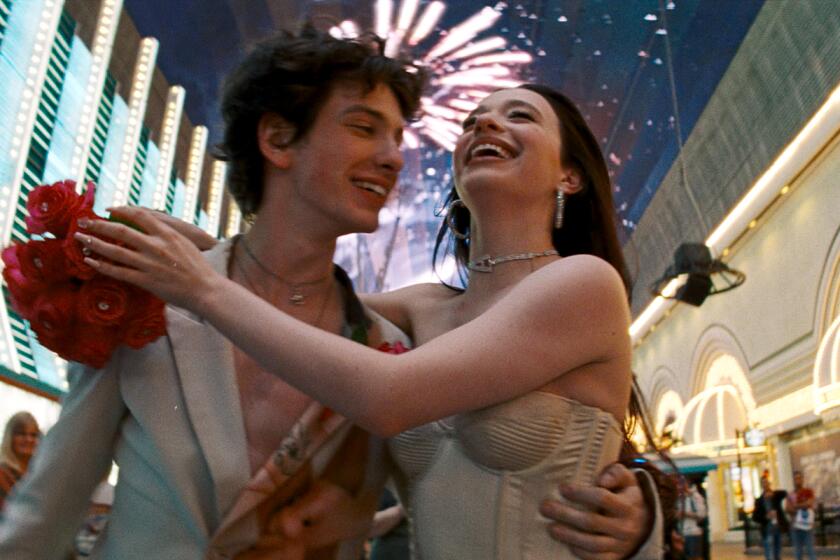Mary J. Blige writes of survivors’ optimism in Oscar shortlisted ‘See What You’ve Done’

After watching the documentary “Belly of the Beast,” Mary J. Blige was incredulous.
“I could not believe what I was seeing,” Blige said. “But somewhere in the back of my mind, all my life, I always felt like women weren’t being treated properly in prisons. Black women were just being treated like slaughtered pigs.”
Directed by Erika Cohn for PBS’s Independent Lens, the 2020 film investigates the widespread sterilization of female inmates in California prisons — predominantly women of color — and the callous, covert system that allowed this illegal practice to continue well into the 21st century. A central figure in the story is Kelli Dillon, a former inmate who was given a hysterectomy against her will.
“I was just really angry, and then I was inspired by this young woman’s strength, to not let the system beat her and destroy her,” said Blige, who channeled her flurry of emotions into “See What You’ve Done,” one of the 15 original songs that made the Academy Awards shortlist this year.
“No matter what they did to her, they couldn’t take away what was hers, which is her life,” Blige added. “I was livid at the beginning when I saw this stuff, and then when I saw her fighting, it was so hopeful.”
Her incredulous anthem begins with the words “What’s going on?” The nine-time Grammy winner said she wasn’t thinking of Marvin Gaye’s classic song when she wrote that line — “It wasn’t intentional; it was probably subconscious” — although it certainly rhymes with the injustice against Black bodies Gaye was decrying in 1971.
Rather, it was Blige’s blunt reaction immediately after seeing the film. “It was like: What the hell?” she said. “Why are Black women being treated like this? This is not right.”
The lyrics continue: “What’s going on, when I gotta fight for a right that is rightfully mine? What’s going on, when the world can decide if a caged bird flies or ever gets a chance to grow? Too many people are invisible. It’s a problem. How can we ignore what’s going? I got questions. I need answers. It’s been too long. Why?”
“This,” Blige noted, “is what I saw when I saw the film.”
She sings with determination over a driving, syncopated rhythm and a thumping beat, courtesy of her regular collaborator DJ Camper.
“It’s an army,” Blige said. “It’s tribal. Black people are always marching for freedom, and this [is a] Black women army, you know, stampeding, marching for their lives — and it’s a lot of them. It’s probably more than what we know.”
Her other cowriters on the song were Nova Wav, the producing and songwriting duo of Brittany “Chi” Coney and Denisia “Blu June” Andrews, who have penned hits for Rihanna and Beyoncé.
Even when she’s making fun dance tracks, Blige said, “I still want to make people feel something. And I could do it on my own, but I love working with Nova Wav. Everyone they touch, they give something real, something with depth and beauty all at the same time.”
Blige’s own voice swirls and harmonizes with her lead melody, creating a kind of vocal army. Moving into the chorus, she declares over hand-claps: “It ain’t over till it’s over. It ain’t over till it’s done, till these shackles are broken. It ain’t over, ’cause some wounds never heal — do you see what you’ve done?”
The documentary ends with a legal victory, but a cloud of sadness and open-ended tragedy still hangs over the credits accompanied by Blige’s song.
“I guess the overhanging darkness is: Who else is being treated like this?” Blige said. “And will they have the strength to come out of the tragedy and the trauma triumphant like this girl did? And besides her being triumphant, she has wounds that will never heal. Like, there’s 80-year-old women still healing from things that have been done to them since they were children.”
After pounding the streets with a mixture of fury and light, “See What You’ve Done” ends with an introspective piano solo. Blige took this rousing call to action and suddenly turned it on the individual hearing it.
“You’re marching, you’re mad, you’re angry,” she said, “but at some point it has to come to a place of calm. The beat is going crazy, the lyrics are going kind of angry and emotional, and then it dies down to the piano — and ‘it ain’t over till it’s over.’ You come to a place where you understand that you’ve got work to do. And that’s always a quiet place.”
Blige “one million percent” believes songs have the power to move the needle on issues like this one — but she said it’s also more personal than that.
“This music is optimism,” she said. “It’s sadness. It’s triumphant. It’s trauma. When something like that happens to you, if you’re a survivor, or you want to survive; this is your music. This is you.”
More to Read
From the Oscars to the Emmys.
Get the Envelope newsletter for exclusive awards season coverage, behind-the-scenes stories from the Envelope podcast and columnist Glenn Whipp’s must-read analysis.
You may occasionally receive promotional content from the Los Angeles Times.







